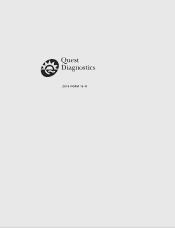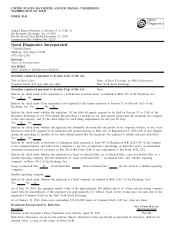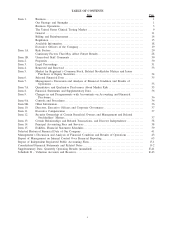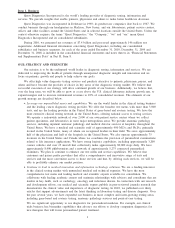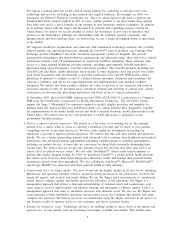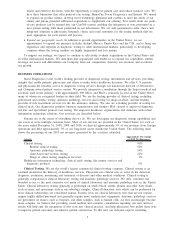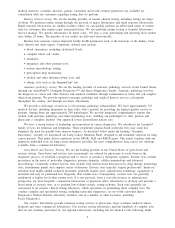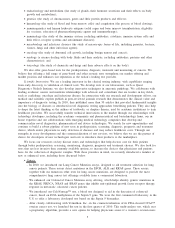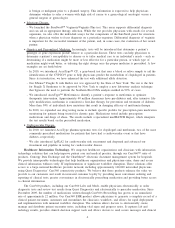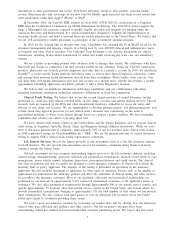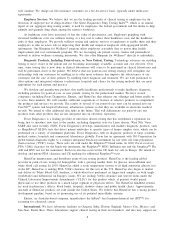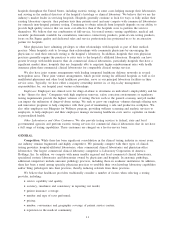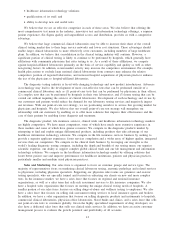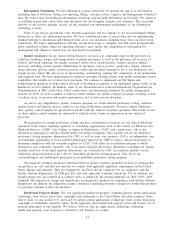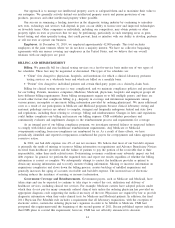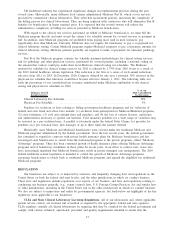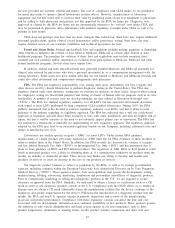Quest Diagnostics 2010 Annual Report Download - page 9
Download and view the complete annual report
Please find page 9 of the 2010 Quest Diagnostics annual report below. You can navigate through the pages in the report by either clicking on the pages listed below, or by using the keyword search tool below to find specific information within the annual report.
is benign or malignant prior to a planned surgery. This information is expected to help physicians
determine whether to refer a woman with high risk of cancer to a gynecological oncologist versus a
general surgeon or gynecologist.
•Infectious Disease.
- We launched the SureSwabTM Vaginosis/Vaginitis Plus test. This assay supports differential diagnosis
and can aid in appropriate therapy selection. While the test provides physicians with results for several
organisms, we also offer the individual assays for the components of the SureSwab panel for situations
when a physician wishes to focus diagnosis on a particular organism. Differential diagnosis of vaginitis
is important for the successful treatment of the patient, and, in some cases, the evaluation of her sexual
partner.
•Genetics and Personalized Medicine. Increasingly, tests will be introduced that determine a patient’s
genotype or gene expression profile relative to a particular disease. These tests can help physicians to
determine a patient’s susceptibility to disease or to tailor medical care to an individual’s needs – such as
determining if a medication might be more or less effective for a particular person, or which type of
medication might work better, or tailoring the right dosage once the proper medicine is prescribed. A few
examples are set forth below:
- In 2010, we introduced AccuTypeTM CP, a gene-based test that uses a blood or saliva sample to aid the
identification of the CYP2C19 gene to help physicians predict the metabolism of clopidogrel in patients.
Since its introduction, we have enhanced the test with additional allele detection.
- Our XSense威Fragile X with Reflex test was approved by the State of New York. The test is the first
for Fragile X Syndrome to be approved by New York to employ a new laboratory analysis technique
that bypasses the need to perform the Southern Blot DNA analysis method in 99% of cases.
- We introduced AccuTypeTM Metformin to identify a patient’s response to metformin to optimize
therapeutic intervention. Approximately 40 million Americans have pre-diabetes and, after intensive life-
style modification, metformin is considered a first-line therapy for prevention and treatment of diabetes.
More than 30% of individuals have mutations that result in changing efficacy of metformin therapy.
- In 2010, we expanded our drug testing menu to include specific profiles for prescription pain medication
monitoring for patients being treated for chronic pain. Medications tested include prescription
medications and drugs of abuse. The results include a specialized medMATCH Report, which interprets
the test results based on the prescribed medication.
•Cardiovascular Disease.
- In 2010, we launched AccuType pharmacogenomic tests for clopidogrel and metformin, two of the most
commonly prescribed medications for patients that have had a cardiovascular event or that have
diabetes, respectively.
- We also introduced LpPLA2 for cardiovascular risk assessment and deepened and advanced our
investment and pipeline in testing for cardiovascular disease.
Healthcare Information Technology. We empower healthcare organizations and clinicians with information
technology solutions that can help improve patient care and medical practice, through our Care360TM suite of
products, Centergy Data Exchange and the ChartMaxx威electronic document management system for hospitals.
We provide interoperable technologies that help healthcare organizations and physicians enter, share and access
clinical information without costly IT implementation or significant workflow disruption. These solutions offer
access to a large national healthcare provider network, including approximately 160,000 networked physicians
using Quest Diagnostics’ Care360 connectivity products. We believe that these products enhance the value we
provide to our customers and result in increased customer loyalty by providing more convenient ordering and
reporting of clinical tests, greater convenience in electronically prescribing medication and providing better access
to clinical information.
The Care360 products, including our Care360 Labs and Meds, enable physicians electronically to order
diagnostic tests and review test results from Quest Diagnostics and electronically to prescribe medication. Since
December 2009, the number of medications written through Care360 ePrescribing has grown to an annualized
rate of approximately 22 million. Our Care360 EHR product allows physicians to generate a complete record of a
clinical patient encounter, automates and streamlines the clinician’s workflow, and allows for rapid deployment
and implementation with minimal workflow disruption. The solution allows doctors to electronically create,
manage and distribute patient encounter notes, including vital signs and progress notes. It captures lab and
radiology results, provides clinical decision support tools and allows doctors to send secure messages and clinical
6

